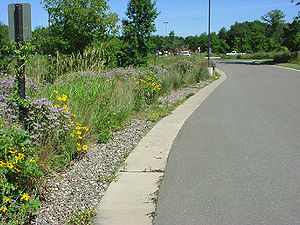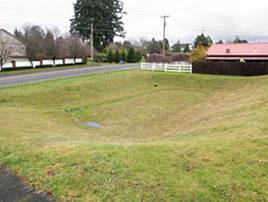
Difference between revisions of "Infiltration"
m |
m |
||
| (21 intermediate revisions by the same user not shown) | |||
| Line 1: | Line 1: | ||
| − | {{alert|We | + | {{alert|We have created this new page called Infiltration, which includes information on infiltration trenches, infiltration basins, dry wells, and underground infiltration practices. This page and the accompanying pages shown below replace the [http://stormwater.pca.state.mn.us/index.php/Infiltration_trench Infiltration trench] and [http://stormwater.pca.state.mn.us/index.php/Infiltration_basin Infiltration basin] sections of the manual.|alert-info}} |
| − | + | [[file:Infiltration trench Lino Lakes.jpg|thumb|300px|alt=Photo of an infiltration trench in Lino Lakes|<font size=3>Photo of a Infiltration trench in Lino Lakes</font size>]] | |
| − | [[file:Infiltration | + | [[file:Infiltration basin 1.jpg|300px|thumb|alt=photo of an infiltration basin|<font size=3>Photo of an infiltration basin. Source: Clark County, Washington, with permission.</font size>]] |
| + | |||
| + | {{alert|Infiltration practices can be an important tool for retention and detention of stormwater runoff and treatment of pollutants in stormwater runoff. If the practice utilizes vegetation, additional benefits may include cleaner air, carbon sequestration, improved biological habitat, and aesthetic value.|alert-success}} | ||
| + | |||
| + | {{alert|Infiltration of stormwater, where appropriate, is a preferred practice for managing stormwater runoff, as it reduces pollutants reaching receiving waters and retains water on the landscape|alert-success}} | ||
Infiltration basins, infiltration trenches, dry wells, and underground infiltration systems capture and temporarily store stormwater before allowing it to infiltrate into the soil. As the stormwater penetrates the underlying soil, chemical, biological and physical processes remove pollutants and delay peak stormwater flows. | Infiltration basins, infiltration trenches, dry wells, and underground infiltration systems capture and temporarily store stormwater before allowing it to infiltrate into the soil. As the stormwater penetrates the underlying soil, chemical, biological and physical processes remove pollutants and delay peak stormwater flows. | ||
| − | These four practices are grouped together because design, construction, operation, and maintenance guidelines and specifications are similar. Differences between these practices, where they exist, are highlighted on each of the following pages. For additional information on other infiltration practices, see Stormwater infiltration Best Management Practices and Bioretention terminology. | + | These four practices are grouped together because design, construction, operation, and maintenance guidelines and specifications are similar. Differences between these practices, where they exist, are highlighted on each of the following pages. For additional information on other infiltration practices, see [[Stormwater infiltration Best Management Practices]] and [[Bioretention terminology]]. |
| + | |||
| + | [[Acknowledgments for infiltration|Acknowledgements]] | ||
<font size=3>Infiltration articles</font size> | <font size=3>Infiltration articles</font size> | ||
| − | *[[Overview for infiltration | + | *[[Overview for infiltration]] |
| − | *[[Types of infiltration | + | *[[BMPs for stormwater infiltration|Types of infiltration]] |
| − | *[[Design criteria for infiltration | + | *[[Design criteria for infiltration]] |
| − | *[[Construction specifications for infiltration | + | *[[Construction specifications for infiltration]] |
| − | *[[Operation and maintenance of infiltration practices]] | + | *[[Operation and maintenance of stormwater infiltration practices]] |
| − | *[[Assessing the performance of infiltration | + | *[[Assessing the performance of infiltration]] |
| − | *[[Calculating credits for infiltration | + | *[[Calculating credits for infiltration]] |
| − | *[[Cost-benefit considerations for infiltration | + | *[[Cost-benefit considerations for infiltration]] |
| − | *[[Case studies for infiltration practices]] | + | *[[Case studies for infiltration]] |
| − | *[[External resources for infiltration | + | *[[Green Infrastructure benefits of infiltration practices]] |
| − | *[[References for infiltration | + | *[[Summary of permit requirements for infiltration]] |
| + | *[[Infiltration photo gallery]] | ||
| + | *[[External resources for infiltration]] | ||
| + | *[[References for infiltration]] | ||
*[[Requirements, recommendations and information for using infiltration basin/underground infiltration BMPs in the MIDS calculator]] | *[[Requirements, recommendations and information for using infiltration basin/underground infiltration BMPs in the MIDS calculator]] | ||
| + | *[[Requirements, recommendations and information for using underground infiltration BMPs in the MIDS calculator]] | ||
| + | *[https://stormwater.pca.state.mn.us/index.php?title=Stormwater_Manual_webinars December 15 webinar] (powerpoint and link to presentation) | ||
==Related pages== | ==Related pages== | ||
*[[Understanding and interpreting soils and soil boring reports for infiltration BMPs]] | *[[Understanding and interpreting soils and soil boring reports for infiltration BMPs]] | ||
*[[Determining soil infiltration rates]] | *[[Determining soil infiltration rates]] | ||
| + | *Cold climate considerations for infiltration practices - See [http://stormwater.pca.state.mn.us/index.php/Cold_climate_impact_on_runoff_management#Infiltration], [http://stormwater.pca.state.mn.us/index.php/Cold_climate_impact_on_runoff_management#Infiltration_practices] | ||
| − | <noinclude>[[Category: | + | <noinclude>[[Category:Level 3 - Best management practices/Structural practices/Infiltration (trench/basin)]]</noinclude> |
Latest revision as of 17:08, 1 February 2023
Infiltration basins, infiltration trenches, dry wells, and underground infiltration systems capture and temporarily store stormwater before allowing it to infiltrate into the soil. As the stormwater penetrates the underlying soil, chemical, biological and physical processes remove pollutants and delay peak stormwater flows.
These four practices are grouped together because design, construction, operation, and maintenance guidelines and specifications are similar. Differences between these practices, where they exist, are highlighted on each of the following pages. For additional information on other infiltration practices, see Stormwater infiltration Best Management Practices and Bioretention terminology.
Infiltration articles
- Overview for infiltration
- Types of infiltration
- Design criteria for infiltration
- Construction specifications for infiltration
- Operation and maintenance of stormwater infiltration practices
- Assessing the performance of infiltration
- Calculating credits for infiltration
- Cost-benefit considerations for infiltration
- Case studies for infiltration
- Green Infrastructure benefits of infiltration practices
- Summary of permit requirements for infiltration
- Infiltration photo gallery
- External resources for infiltration
- References for infiltration
- Requirements, recommendations and information for using infiltration basin/underground infiltration BMPs in the MIDS calculator
- Requirements, recommendations and information for using underground infiltration BMPs in the MIDS calculator
- December 15 webinar (powerpoint and link to presentation)
Related pages
- Understanding and interpreting soils and soil boring reports for infiltration BMPs
- Determining soil infiltration rates
- Cold climate considerations for infiltration practices - See [1], [2]
This page was last edited on 1 February 2023, at 17:08.

